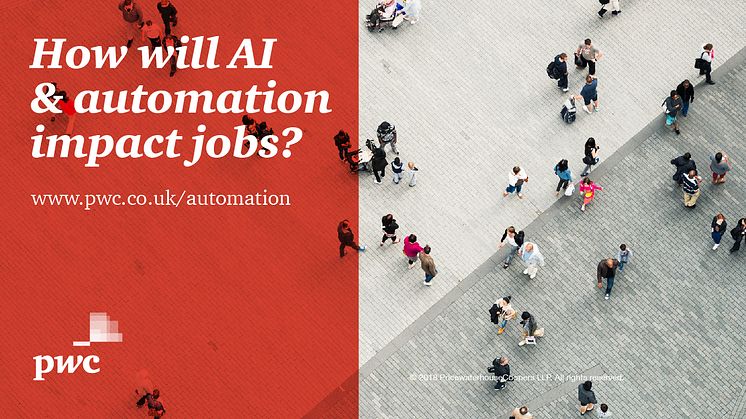
Press release -
Education and retraining critical to help workers adjust to future waves of automation
| Date | 6 February 2018 |
| Contact |
Natalie Choo, PwC Singapore, Communications Mobile: +65 8722 7545 E-mail: natalie.yl.choo@sg.pwc.com Rowena Mearley, PwC Global, Communications Mobile: +44 207 213 4727 / + 44 7730 598 643 Email: rowena.w.mearley@pwc.com |
- PwC identifies three waves of automation between now and the mid-2030s and how it will impact jobs
- Transport and manufacturing sectors have relatively high potential for job automation by the 2030s, health and education are less automatable
- Education is a key factor driving risk of automation, with less well educated men at highest risk in the long run
- But women could be at the higher risk over the next 5-10 years, for example in clerical roles
- There should be broadly offsetting job gains provided increased investment is made in retraining
The impacts of three overlapping waves of automation to the 2030s are examined in a new report published today by PwC: the algorithm wave, the augmentation wave and the autonomy wave.
The research analysed the tasks and skills involved in the jobs of over 200,000 workers across 29 countries in order to assess the potential impact of automation on workers in different industry sectors and of different genders, ages and education levels.
On average across the 29 countries covered, the share of jobs at potential high risk of automation is estimated to be only around 3% by the early 2020s, but this rises to almost 20% by the late 2020s, and around 30% by the mid-2030s.
The study suggests that more women could initially be impacted by the rise of automation, whereas men are more likely to feel the effects in the third wave by the mid-2030s (see table below). This is due to the types of tasks that are more susceptible to automation and the current gender profiles of employment by sector.
The Algorithm wave is already well underway and involves automating structured data analysis and simple digital tasks, such as credit scoring. This wave of innovation could come to maturity by the early 2020s.
The Augmentation wave is also already underway but likely to come to full maturity later in the 2020s.The augmentation wave is focused on automation of repeatable tasks and exchanging information, as well as further developments of aerial drones, robots in warehouses and semi-autonomous vehicles.
In the third Autonomy wave, which could come to maturity by the mid-2030s, AI will increasingly be able to analyse data from multiple sources, make decisions and take physical actions with little or no human input. Fully autonomous driverless vehicles could roll out at scale across the economy in this phase, for example.
The table below summarises estimates of the proportion of jobs that could be impacted over these three waves and how this might vary for male and female workers.
| Wave | Cumulative % of jobs analysed that could be impacted by automation | % of female workers that could be impacted | % of male workers that could be impacted |
| Algorithm wave - to early 2020s | 3% | 4% | 2% |
| Augmentation wave - to late 2020s | 19% | 23% | 16% |
| Autonomy wave - by mid 2030s | 30% | 26% | 34% |
- Source: PwC estimates of median values across 29 countries based on analysis of OECD PIAAC data
Pierre Legrand, Asia Pacific Technology Consulting Leader, PwC, commented that:
“There is an immense opportunity to upskill and train the modern workforce on new skills and capabilities that will be invaluable to modern enterprise as business problems become more complex. We believe that the use of intelligent machines will drive greater productivity, gain more time for human interaction to predict or solve challenge problems in a disruptive global climate, and create deeper relationships with colleagues and clients as a result of the disruption by AI. These are very exciting times for the modern workforce and should be seen as a major opportunity for firms to focus on enterprise value as opposed to commodity cost reduction strategies.”
Potential impacts by country
The estimated proportion of existing jobs with high potential automation rates by the mid-2030s varies significantly by country.
These estimates range from only around 20-25% in some East Asian and Nordic economies with relatively high average education levels, to over 40% in Eastern European economies where industrial production, which tends to be easier to automate, still accounts for a relatively high share of total employment.
Countries like the UK and the US, with services-dominated economies but also relatively long ‘tails’ of lower skilled workers, tend to have intermediate potential automation rates.

Mark Jansen, Data and Analytics Leader, PwC Singapore says:
“AI will have dramatic implications on the workforce of the future, this is no different to previous industrial revolutions. We are already seeing schools in Singapore adjusting their curriculum to groom more data and AI skills. As we look to the future, skills training will shift from hard skills such as more technical know-howto softer skills such as relational and problem solving skills.
“In Singapore and across the Asia region we are starting to see the divergence of companies that are using data and those that are not. Fundamentally all organisations need to pivot not just to automating a process, but revisiting how they operate.”
Potential impacts by industry sector
The estimated share of existing jobs with potential high rates of automation by the mid-2030s varies widely across industry sectors, from a median across countries of 52% for transportation and storage to just 8% for the education sector.
Transport stands out as a sector with particularly high longer term potential automation rates as driverless vehicles roll out at scale across economies, but this will be most evident in the third wave of autonomous automation. In the shorter term, sectors such as financial services could be more exposed as algorithms outperform humans in an ever wider range of tasks involving pure data analysis.

Potential impacts by gender, age, education
Our analysis also highlights significant differences across types of workers and these will also vary across our three waves of automation (see chart below). The starkest results are those by education level, with much lower exposures on average for highly educated workers with graduate degrees or above, than for those with low to medium education levels.
In the long run, less well educated workers could be particularly exposed to automation, emphasising the importance of increased investment in lifelong learning and retraining
More highly educated workers will typically have greater potential for adaptability to technological changes, for example in senior managerial roles that will still be needed to apply human judgement, as well as to design and supervise AI-based systems. Such workers should see their wages increase due to the productivity gains that these new technologies should bring.
Differences are less marked by age group, although some older workers could find it relatively harder to adapt and retrain than younger cohorts. This may apply particularly to less well-educated men as we move into our third wave of autonomous automation in areas like driverless cars and other manual labour that has a relatively high proportion of male workers at present. But female workers could be relatively harder hit in early waves of automation that apply, for example, to clerical roles.

Implications for public policy
Automation rates also differ across countries because ways of working differ. In particular, workers in countries such as Singapore and South Korea with more stringent educational requirements could have greater protection against automation in the long run. This is also true (particularly in Europe) for countries with higher levels of education spending as a percentage of GDP.
Mark Jansen, Data and Analytics Leader, PwC Singapore, commented that:
“Automation has always struck fear in most workers and today this is becoming even more wide spread. Notwithstanding, automation brings opportunity. Opportunities for a more productive workforce and retraining into new growth areas.
“Singapore’s Skillsfuture program is aimed directly at addressing this need and the country has a chance to replicate its historic success of transforming the economy and its people. The critical ingredient should not be fear of change, but fear of not changing.”
Ends
Download the report at https://www.pwc.co.uk/automation
Notes
1.The methodology used in this study buildMs on previous research by Frey and Osborne (2013), Arntz, Gregory and Zierahn (2016) and our previous research on this topic in PwC’s UK Economic Outlook (March 2017). For further details please see the Annex of the full report located at https://www.pwc.co.uk/automation
2.In a survey of 10,000 people world wide by PwC for its Workforce of the Future study, PwC found that almost three quarters (74%) of people surveyed are ready to learn a new skill or completely retrain to keep themselves employable, seeing it as their personal responsibility and not employers, to keep their skills updated. Their views reinforce a shift to continuous learning while earning, so employees can keep up with technology’s impact on jobs and the workplace. Find out more here.
3.PwC analysis published in June 2017 shows that Global GDP will be 14% higher in 2030 as a result of AI – the equivalent of an additional $15.7 trillion. This makes it the biggest commercial opportunity in today’s fast changing economy. Find out more here
Related links
Topics
Categories
About PwC
At PwC, our purpose is to build trust in society and solve important problems. We’re a network of firms in 158 countries with more than 236,000 people who are committed to delivering quality in assurance, advisory and tax services. Find out more and tell us what matters to you by visiting us at www.pwc.com.
PwC refers to the PwC network and/or one or more of its member firms, each of which is a separate legal entity. Please see www.pwc.com/structure for further details.
© 2017 PwC. All rights reserved


